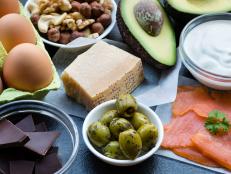What Is Flexitarianism?
The term often refers to a largely vegetarian diet, with some mindful flexibility around meat — and could be the approach that helps you stick to your goals longterm, without feeling like you’re missing out.

marilyna/Getty Images
It can be confusing to figure out what pattern of eating is best for you. Everyone eats differently for a myriad of reasons – health, chronic conditions, cultural and religious beliefs, cost. One way to ensure that diets – or really, patterns or styles of eating – are executed properly is by understanding the how and why, and making sure that within any diet, you’re still getting all the nutrients you need. Proper diets also require some flexibility – having options both at home, and while dining out.
As a registered dietician, I’m often asked whether meat is bad, and if it’s better to go plant-based, vegetarian, vegan or paleo. The truth is, your eating pattern is a personal decision, and should be based on what’s best for you. In my practice, I guide my patients toward being more flexible with their diets, as long as it’s in line with their preferences. This approach is referred to as Flexitarianism, and it’s on the rise.
What Is Flexitarianism?
A Flexitarian eating pattern often refers to eating primarily vegetarian, with some flexibility around consuming animal products, whether it be for social, environmental, nutritional or personal reasons. Inherently, flexitarianism is not concretely defined, but is borne of the idea that people can still be plant-forward, while incorporating foods from animals, such as eggs, meats, cheese and more. The concept creates a loose framework for those who want to eat largely plant-based foods, without the rigidity of a vegan or vegetarian diet. If you’re flexible with your eating, you have more options, and ultimately won’t be pigeonholed by a restrictive style of eating.
What Are the Benefits of Being Flexitarian?
Plant-based, but at a Texan barbecue spot? No worries. If the majority of your meals that week are still plant-forward, then you are honoring your dietary preferences, while releasing any shame or guilt around your choice for that meal. This allows you to maintain eating styles long-term, without depriving yourself of fun, fruitful experiences.
There’s a lot of information on the benefits of eating strictly vegetarian or strictly meat. Upon review of the various studies, it’s safe to say there are pros and cons to both ways of eating. Eating more plant-forward can help with management of some chronic conditions such as elevated lipids. But it’s also important to remember that vitamins like B12, calcium and iron aren’t as readily available from plant-based foods as they are from meat. Eating fully vegetarian does require a little more thoughtfulness in order to make sure your food intake is varied and you’re getting all the nutrients you need.
Eating meat is great in that it provides plenty of iron, B vitamins and protein, which helps you feel satiated. However, over-consumption of meat is of concern due to increased calories from fat, higher levels of sodium and more cholesterol – all of which are associated with an increased risk of heart disease. We have also learned that increased meat consumption puts us at risk for elevated blood pressure, stroke and greater risk of certain cancers, especially colorectal.
What Are the Challenges of Flexitarianism?
The challenges around flexitarianism are mostly tied to confusion around what it actually means. But the beauty of the style is that it can mean a lot of different things. Being a flexitarian means you can execute your eating pattern in virtually any way that you want, which may ultimately leave you feeling confused. Doing what feels right is generally a good place to start. Additionally, there are resources out there, like leveraging education from a registered dietician, that can help you navigate the specifics for your personal health.
Specifics aside, here are some general takeaways that can set you on the right path:
It is possible to eat meat and still be healthy. Meat is a good source of B vitamins, high biological value protein, iron and zinc. Selenium found in organ meats is also thought to have antioxidant properties known to ward off cancer. Higher protein diets are also said to help with blood sugar control and weight management. But mindfulness is key here.
With any healthy eating pattern, always be sure to incorporate whole grains, fruits and vegetables daily to get ample fiber and maintain a varied diet.
Bottom Line: Maintaining a varied, mindful diet can give you more flexibility, allowing you to maintain personal eating pattern goals, while relieving you of rigidity (and any guilt or shame) when you aren’t close to home, are enjoying a meal out or are in certain social settings.
Related Content:

































